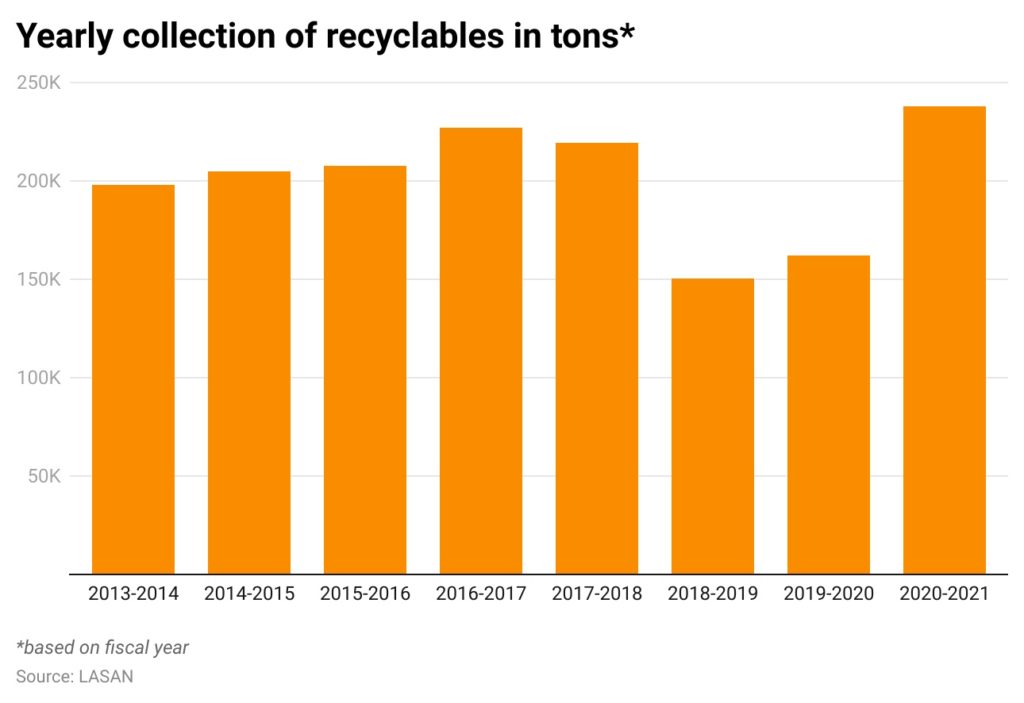Blue bins and beyond

Everyone is in favor of recycling, but ensuring that it happens on a wide enough and efficient scale is no easy feat. Every weekday in Los Angeles, as many as 115 trucks may be handling recycling across the city. The pandemic only added new challenges, as Angelenos ordered more items online.
One of those responsible for making sure the right stuff gets moved in and out of the blue bins is James Moore, a division manager with Los Angeles Sanitation & Environment (LASAN). Moore is in charge of the East and West Valley districts and has spent 33 years working for the department. As part of a series on operations in the region, he spoke with Crosstown about how Angelenos can improve their recycling habits and what other changes will help the city meet its goal of zero waste.
This interview has been lightly edited for length and clarity.
Crosstown: What are the biggest challenges the city faces with its recycling?
James Moore: We have a few different challenges. For a while, we were sending all of our recyclables to China. That market pretty much dried up. And in the beginning, we were actually getting paid for recycling. We are getting back to that now. The trend is starting to move back toward us being reimbursed.
Q: What is the biggest issue Los Angeles has to tackle when it comes to its waste?
A: Illegal dumping. There have been reports that some materials that are being dumped on our streets are coming from people outside of the city. They just don’t want it recorded that they are dumping, or they have material and they just pretty much dump it wherever they can.
[Get COVID-19, crime and other stats about where you live with the Crosstown Neighborhood Newsletter]
Q: How did the pandemic change what Angelenos were recycling?
A: During the pandemic, especially at the peak, we did see a high increase in recycling, because people were ordering more boxes through sites like Amazon. So there was a lot more cardboard out there.

Q: Are you still seeing that?
A: It’s starting to level off, but we haven’t seen a big decrease in the tonnage that we’re picking up. Once people got used to ordering things via their cell phone, it became a convenience they really took to. We’re still seeing a lot of boxes. Our peak season, as far as recycling, is always going to be around the holidays.
Q: What would a more efficient system for collecting waste and recycling look like?
A: I would like to see a more streamlined way of operation. I’d like to see us go into different ways of collecting, such as more efficient vehicles. I know electrification is on the horizon. Removing more stuff from the landfills would be a beautiful thing. When I first started, we had landfills all over the place and it was really nice to see that we are becoming more and more efficient in our recycling programs. Hopefully we’ll get to that zero waste goal sooner than later.
Q: Do Angelenos know how to recycle?
A: I think we can always do better as far as getting the message across on what is recyclable and what is not. We do have an ambassador program and we’re trying to ramp that back up. They would help residents understand what is, and what is not recyclable. We’re understaffed on that right now.
Q: How much money does the City make annually from recyclables?
A: The City’s recyclable materials were generating over $6 million per year in revenue, helping to offset LASAN’s operational costs. Unfortunately, for the last couple of years, the City paid over $13 million to recycle the blue-bin materials.
Want to know more about where you live? Check out the Crosstown neighborhood map or send us an email at askus@xtown.la.






